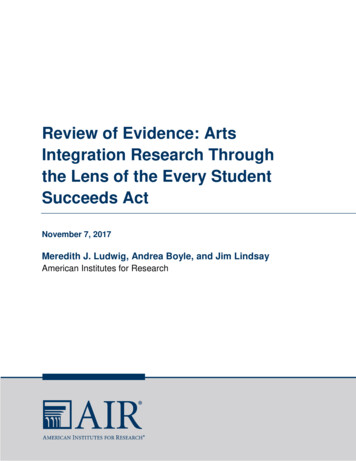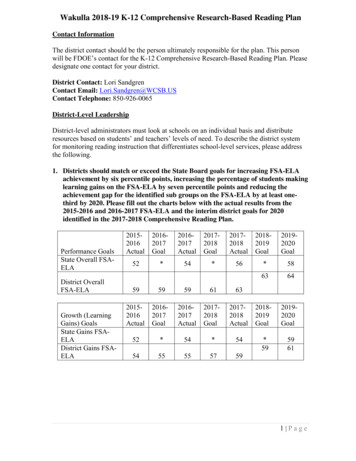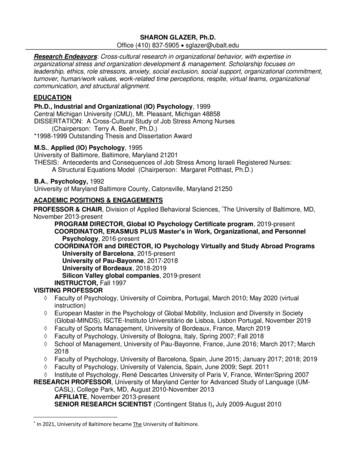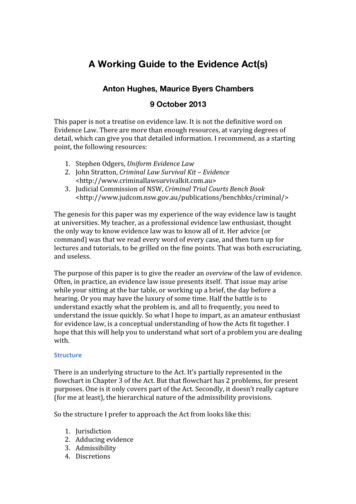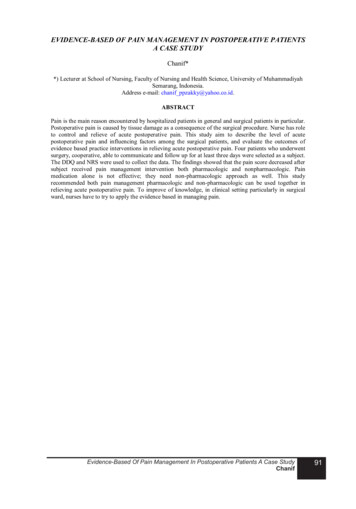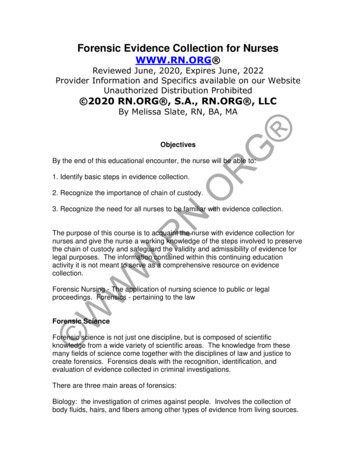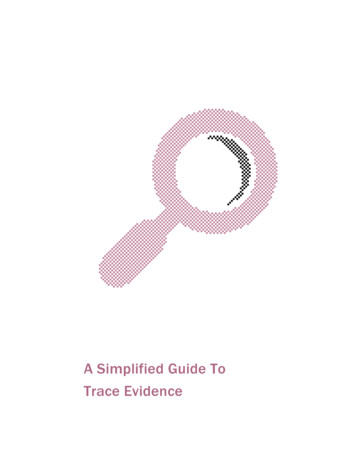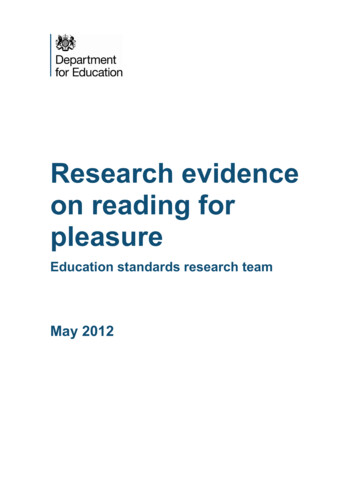
Transcription
Research evidenceon reading forpleasureEducation standards research teamMay 2012
ContentsIntroduction3Key findings3The evidence on reading for pleasure3What works in promoting reading for pleasure?6Definitions8The evidence on reading for pleasure9Benefits of reading for pleasure9Trends in reading for pleasure13Changes in numbers of children reading for pleasure over time15Children’s perceptions of readers15Types of reading16Reasons children read17Gender differences in reading for pleasure18What works in promoting reading for pleasure?21Strategies for improving independent reading21Online reading habits24The role of librarians in reading for pleasure26Library use and reading for pleasure26References282
IntroductionThe first section of this briefing note highlights research evidence on reading forpleasure from domestic and international literature; exploring evidence on thetrends and benefits of independent reading amongst both primary andsecondary- aged children, as well as why children read. The second section ofthis briefing covers the evidence on what works in terms of promoting readingfor pleasure.Key findingsThe evidence on reading for pleasureBenefits of reading for pleasure: There is a growing body of evidence which illustrates the importance ofreading for pleasure for both educational purposes as well as personaldevelopment (cited in Clark and Rumbold, 2006). Evidence suggests that there is a positive relationship between readingfrequency, reading enjoyment and attainment (Clark 2011; Clark andDouglas 2011). Reading enjoyment has been reported as more important for children’seducational success than their family’s socio-economic status (OECD,2002). There is a positive link between positive attitudes towards reading andscoring well on reading assessments (Twist et al, 2007). Regularly reading stories or novels outside of school is associated withhigher scores in reading assessments (PIRLS, 2006; PISA, 2009). International evidence supports these findings; US research reports thatindependent reading is the best predictor of reading achievement(Anderson, Wilson and Fielding, 1988). Evidence suggests that reading for pleasure is an activity that hasemotional and social consequences (Clark and Rumbold, 2006). Other benefits to reading for pleasure include: text comprehension andgrammar, positive reading attitudes, pleasure in reading in later life,increased general knowledge (Clark and Rumbold, 2006).3
Trends in reading for pleasure In general, the available evidence suggests that the majority of childrensay that they do enjoy reading (Clark and Rumbold, 2006). In 2010, 22% of children said they enjoyed reading very much; 27% saidthey enjoyed it quite a lot; 39% said they enjoyed it quite a bit, and 12%reported that they did not enjoy reading at all (Clark 2011). Comparing against international evidence, children in England report lessfrequent reading for pleasure outside of school than children in manyother countries (Twist et al, 2007). There is consistent evidence that age affects attitudes to reading andreading behaviour; that children enjoy reading less as they get older(Topping, 2010; Clark and Osborne, 2008; Clark and Douglas 2011).However, some evidence suggests that while the frequency with whichyoung people read declines with age, the length for which they read whenthey read increases with age (Clark 2011). A number of studies have shown that boys enjoy reading less than girls;and that children from lower socio-economic backgrounds read less forenjoyment than children from more privileged social classes (Clark andRumbold, 2006; Clark and Douglas 2011). Some evidence has shown children from Asian background have morepositive attitudes to reading and read more frequently than children fromWhite, mixed or Black backgrounds (Clark and Douglas 2011).Changes in numbers of children reading for pleasure over time Research is accumulating that suggests that a growing number ofchildren do not read for pleasure (Clark and Rumbold, 2006). Between 2000 and 2009, on average across OECD countries thepercentage of children who report reading for enjoyment daily dropped byfive percentage points (OECD, 2010). This is supported by evidence from PIRLS 2006 (Twist et al, 2007) whichfound a decline in attitudes towards reading amongst children.4
Children’s perceptions of readers A greater percentage of primary than secondary aged children viewthemselves as ‘a reader’ (Clark and Osborne, 2008). A greater proportion of primary aged readers and non-readers (thansecondary aged) believed that their friends saw readers as happy andpeople with a lot of friends (Clark and Osborne, 2008).Types of reading Text messages, magazines, websites and emails have been found to bethe most common reading choices for young people. Fiction is readoutside the class by two-fifths of young people (Clark and Douglas 2011). Some evidence suggests that more young people from Whitebackgrounds read magazines, text messages and messages on socialnetworking sites and more young people form Black backgrounds readpoems, eBooks and newspapers (Clark 2011). Twist et al (2007) report a slight increase in the proportion of children whoclaim to be reading comics/comic books and newspapers at least once ortwice a week in England. There is mixed evidence on whether primary or secondary children read agreater variety of materials (Clark and Osborne, 2008; Clark and Foster,2005). Young people who receive 1 free school meals (FSM) are less likely toread fiction outside of the classroom (Clark 2011). Most young people read between one and three books in a month (Clarkand Poulton 2011b).Reasons children read Reading for pleasure is not always cited as the key reason for childrenreading. Other reasons include skills-based reasons or reasons to do withlearning and understanding (Nestle Family Monitor, 2003; Clark andFoster, 2005). Another popular reason given is emotional – relating to the way readingmakes children feel (Dungworth et al, 2004).1The surveys reported on pupils who received or did not receive free school meals (FSM)rather than pupils who were FSM eligible or not.5
Gender differences in reading for pleasure A number of studies have shown that boys enjoy reading less than girls. Evidence has found that 58% of girls enjoy reading either very much orquite a lot in comparison to 43% of boys (Clark and Douglas 2011). In all countries, boys are not only less likely than girls to say that theyread for enjoyment, they also have different reading habits when they doread for pleasure; with girls more likely to read fiction or magazines, andboys more likely to read newspapers or comics (OECD, 2010). Evidence from the Programme for International Student Assessment(PISA) has shown that boys are on average 39 points behind girls inreading, the equivalent of one years schooling. One study reports that boys are reading nearly as much as girls, but theytend to read easier books (Topping, 2010).What works in promoting reading for pleasure?Strategies to improve independent reading Having access to resources and having books of their own has an impacton children’s attainment. There is a positive relationship between theestimated number of books in the home and attainment (Clark 2011).Children who have books of their own enjoy reading more and read morefrequently (Clark and Poulton 2011). An important factor in developing reading for pleasure is choice; choiceand interest are highly related (Schraw et al, 1998; Clark and PhythianSence, 2008) Literacy-targeted rewards, such as books or book vouchers have beenfound to be more effective in developing reading motivation than rewardsthat are unrelated to the activity (Clark and Rumbold, 2006). Parents and the home environment are essential to the early teaching ofreading and fostering a love of reading; children are more likely tocontinue to be readers in homes where books and reading are valued(Clark and Rumbold, 2006). Reading for pleasure is strongly influenced by relationships betweenteachers and children, and children and families (Cremin et al, 2009).6
Online reading habits There is little research that has been conducted specifically looking atonline reading habits; the existing evidence has mixed results. Twist et al (2007) report finding a negative association between theamount of time spent reading stories and articles on the internet andreading achievement in most countries in PIRLS data. However, other research finds that those reading from the internet scorewell in reading assessments (Scottish analysis of PISA data, 2004), andPISA reports that young people who are extensively engaged in onlinereading activities are generally found to be more proficient readers(OECD, 2010).Library use and reading for pleasure Research reports a link between library use and reading for pleasure;young people that use their public library are nearly twice as likely to bereading outside of class every day (Clark and Hawkins, 2011).7
DefinitionsAs Clark and Rumbold (2006) note, the terms ‘reading for pleasure’, ‘reading forenjoyment’ and their derivates are used interchangeably. Reading for pleasureis also frequently referred to, especially in the US, as independent reading(Cullinan, 2000), voluntary reading (Krashen, 2004), leisure reading (Greaney,1980), recreational reading (Manzo and Manzo, 1995) or ludic reading (Nell,1988, all cited in Clark and Rumbold, 2006).Reading for pleasure has been defined by the National Literacy Trust as“reading that we do of our own free will, anticipating the satisfaction that we willget from the act of reading. It also refers to reading that having begun atsomeone else’s request we continue because we are interested in it” (Clark andRumbold, National Literacy Trust, 2006).The process of reading for pleasure has also been described as a form of playthat ‘allows us to experience other worlds and roles in our imagination’ (Nell,1988 – cited in Clark and Rumbold, 2006), and a creative activity or activeprocess (Holden, 2004; Pullman, 2004 – cited in Clark and Rumbold, 2006).8
The evidence on reading for pleasureBenefits of reading for pleasureA growing number of studies show that promoting reading can have a majorimpact on children and adults and their future. Upon reviewing the researchliterature, Clark and Rumbold (2006) identify several main areas of the benefitsto reading for pleasure: Reading attainment and writing ability; Text comprehension and grammar; Breadth of vocabulary; Positive reading attitudes; Greater self-confidence as a reader; Pleasure in reading in later life; General knowledge; A better understanding of other cultures; Community participation; and A greater insight into human nature and decision-making.Evidence suggests that reading for pleasure leads to increased attainment.Clark and DeZoya (2011) found a significant positive relationship betweenenjoyment and attainment indicating that pupils who read more are also betterreaders. Although they made no inference about causality, therefore higherattainment may lead to more enjoyment of reading or greater enjoyment maylead to higher attainment. Similarly Clark (2011) in a large scale survey of over18,000 young people found that those who reported enjoying reading very muchwere six times more likely than those who did not enjoy reading to read abovethe expected level for their age. Young people who reported not enjoyingreading at all were 11 times more likely than those who enjoyed reading verymuch to read below the level expected for their age. Evidence from OECD(2002) found that reading enjoyment is more important for children’s educationalsuccess than their family’s socio-economic status. Clark and Rumbold (2006)argue that reading for pleasure could be one important way to help combatsocial exclusion and raise educational standards.Research has shown that children who read at or above the expected level fortheir age hold more positive attitudes towards reading than children who readbelow the level for their age Clark and DeZoya (2011). There is a link betweenpositive attitudes towards reading and scoring well on reading assessments; for9
example PIRLS 2 (Progress in International Reading Literacy Study) data (Twistet al, 2007) found that children with the most positive attitudes to reading weremore likely to do well on the PIRLS reading assessments. There is also arelationship between reading frequency and attainment (Clark and Douglas2011; Clark 2011) Clark and Douglas (2011) in their survey of 17,000 youngpeople found that those who were at or above the expected reading level fortheir age read more frequently than young people who are below the expectedlevel for their age. Clark (2011) found only one in 10 young people who readrarely or never read scored above the level expected for their age comparedwith one in three of young people who read every day. PIRLS also reports apositive relationship between frequency of reading for pleasure and scores onPIRLS literacy tests (Figure 1).2PIRLS is an international study of reading and literacy, the Progress in International ReadingLiteracyStudy.10
Figure 1:580Literacy score (international average 500)570How reading frequency and purpose correlates to 2006 PIRLSliteracy scores for England575Novels and StoriesReading for InformationReading for 0502492490480Every day or almost every dayOnce or twice a weekOnce or twice a monthNever or almost neverFrequency of readingSource: DfE internal analysis based on PIRLS data (2006)Figure 1 relates reading frequency and reading materials to PIRLS scores. The keyfinding is that frequent reading for pleasure is correlated to higher PIRLS literacyscores. However, reading for information is much less well correlated. The graphshows that 3: Frequently reading novels and stories and reading for fun (regardless ofwhether this is through books, magazines or the internet) is strongly correlatedto PIRLS literacy score. The proportion of children who reported that they seldom read stories ornovels outside school has also increased significantly between 2001 and 2006in England. However, reading for information (regardless of the source) is much less wellcorrelated. Those who reported the most frequent reading of information texts,3‘Reading for fun’ ‘never or almost never’ is amalgamated in to ‘less than twice a month’ in the sourcedata but is shown separated here for visual simplicity. This graph is drawn from data in chapter4 of the full international PIRLS 2006 report.11
tended to have lower attainment; those who read for information only once ortwice a month score highest and those who read for information every dayscore the lowest. Between 2001 and 2006, there was also a significant increase in theproportion of children in England who claimed to ‘never’ or ‘almost never’ readfor information when not in school (Twist et al, 2007).The PIRLS 2006 data of school children aged 9 to 10 shows that those who readstories or novels outside of school ‘every day or almost every day’ score significantlyhigher (with a standardised overall score of 573) compared to those that do so onceor twice a week (535). Those who read once or twice a month scored 536 and thosewho read never or almost never scored on average 492. It must be noted that this isan association, but does not prove a casual one way link. It is likely that being abetter reader will influence how frequently a child reads.These findings are supported by evidence from PISA (The Programme forInternational Student Assessment); PISA results from 2009 show that in all countries,young people who enjoy reading the most perform significantly better in readingliteracy assessments than who enjoy reading the least. There has been considerabledebate as to what type of reading may be most effective in fostering reading skillsand improving reading performance. The results from PISA suggest that, althoughyoung people who read fiction are more likely to achieve high scores, it is youngpeople who read a wide variety of material who perform particularly well in reading(OECD, 2010).Compared with not reading for enjoyment at all, reading fiction for enjoyment appearsto be positively associated with higher scores in the PISA 2009 reading assessment,while reading comic books is associated with little improvement in reading proficiencyin some countries, and with lower overall reading performance in other countries.Also, young people who are extensively engaged in online reading activities, such asreading e-mails, chatting on line, reading news on line, using an online dictionary orencyclopaedia, participating in online group discussions and searching forinformation on line, are generally more proficient readers than young people who dolittle online reading (OECD, 2010).International evidence comes to the same conclusion. In the US, Anderson, Wilson,and Fielding (1988) investigated a broad array of activities and their relationship toreading achievement and growth in reading. They found that the amount of timechildren spent in independent reading was the best predictor of reading achievementand also the best predictor of the amount of gain in reading achievement made bychildren between second grade (aged 7 to 8) and fifth grade (aged 10 to 11).In PIRLS data, the highest rates of children reporting reading for fun were found inthe Russian Federation, where 58% of children reported reading for fun (which wasalso the highest achieving country). There was however no clear inter-country12
relationship between attainment and the amount of reading outside of school. Forexample, children in Singapore reported less reading for pleasure outside of schoolbut had considerably higher achievement in PIRLS.That said, in England (and in most other countries) there was a positive associationbetween the frequency of reading for pleasure and reading attainment. England hadthe greatest difference between the mean attainment of children who read for fun(outside of school) on a daily basis (mean scale score 575) and those who read on aweekly basis (mean scale score 537), a difference of 38 points (Twist et al, 2007).Reading for pleasure is an activity that has real emotional and social consequences.There is a growing body of evidence which illustrates the importance of reading forpleasure for both educational purposes as well as personal development. Theevidence strongly supports the argument that those who read more are betterreaders; and the amount of reading and reading achievement are thought to bereciprocally related to each other – as reading amount increases, readingachievement increases, which in turn increases reading amount (Cunningham andStanovich, 1998 – cited in Clark and Rumbold, 2006). Children who read very little donot have the benefits that come with reading, and studies show that when strugglingreaders are not motivated to read, their opportunities to learn decrease significantly(Baker, Dreher and Guthrie, 2000 – cited in Clark and Rumbold, 2006).Trends in reading for pleasureIn general, the available evidence suggests that the majority of children say that theydo enjoy reading. Overall in their survey Clarke and Douglas (2011) found youngpeople held positive attitudes towards reading. Most agreed that reading is importantand that they enjoy it. They disagreed that reading is boring or hard and that theycannot find anything interesting to read. Most also disagreed that they only read inclass or read only because they have to. Research suggests that girls tend to enjoyreading more than boys. However reading for pleasure is not only related to genderbut also to age; it decreases in the teenage years and early adulthood but increasesagain later in life (Clark and Rumbold, 2006; Clark, Torsi and Strong, 2005; NestleFamily Monitor, 1999; Clark and Douglas 2011). Girls and younger pupils are morelikely to consider that reading is important to succeed in life (Clark and Douglas2011).In terms of enjoyment of reading, research has shown that in 2010, 22% of childrenaged eight to sixteen said they enjoyed reading very much, 27% said they enjoyed itquite a lot, 39% said they liked it quite a bit and 12% reported that they did not enjoyreading at all (Clark et al, 2011). In terms of frequency Clark (2011) found that mostyoung people read outside of class every day (29%) or two to three times a week(26%). Sixteen percent of pupils said they rarely read outside the classroom and 7%did not read outside of class. Girls read outside the classroom more frequently than13
boys, with three in 10 in comparison to 2 in 10 boys reading everyday. Clark (2011)reported that 30 minutes was the most commonly cited length of time for youngpeople report reading for.Comparing against international evidence across OECD countries measured in 2009,on average 37% of children – and 45% or more in Austria, the Netherlands, andLuxembourg – report that they do not read for enjoyment at all. Children in Englandreported less frequent reading for pleasure outside of school than children in manyother countries. Only a third of children reported reading for fun 4 on a daily basisoutside of school, in 2006, compared to the international average of 40% (Twist et al,2007).There is consistent evidence that age affects attitudes to reading and readingbehaviour; that children enjoy reading less as they get older. Clark and Douglas(2011) found that KS2 pupils enjoyed reading significantly more than their oldercounterparts and that reading frequency declines with age. They reported that pupilsin KS2 read more frequently than those in KS3 who in turn read more frequently thanthose in KS4. Pupils in KS2 were also more likely to rate themselves as betterreaders. This is supported by research involving 1,600 children. It found that asignificantly greater proportion of primary than secondary children indicated that theyenjoyed reading very much or quite a lot; 73% compared to 55% (Clark and Osborne,2008). Clark (2011) however, reported that while the frequency with which youngpeople read declines with age, the length for which they read when they readincreases with age.Topping (2010) found that both boys and girls tended to choose books that wereeasier to read once they reach age 11. Frequency of reading also appears to changewith age. This finding is supported by another study which found that although 30%of children aged 5-8 were classified as high frequency readers (i.e. they read a bookevery day) only 17% of those aged 15-17 read every day (Scholastic, 2008 cited byClark and Osborne, 2008).There is some evidence to suggest that reading frequency and enjoyment is linked tosocio-economic status. Clark and Douglas (2011) found that pupils who did notreceive FSM had more positive attitudes to reading but the relationship is weak. Theyreported that around 4% more of children not on free school meals enjoy readingmore than children on free school meals and pupils who receive FSM read lessfrequently. In terms of ethnicity Clark and Douglas (2011) found that young peoplefrom Asian backgrounds tended to hold more positive attitudes towards reading andread more frequently than young people from White, Mixed or Black backgrounds.Clark (2011) reported that young people from White backgrounds tend to enjoyreading the least.4The PIRLS questionnaires specifically asked pupils about whether they ‘read for fun outside ofschool’.14
Changes in numbers of children reading for pleasure overtimeResearch is accumulating that suggests that a growing number of children do notread for pleasure (Clark and Rumbold, 2006). Available evidence shows a decline inthe numbers of children reading for pleasure over time. Between 2000 and 2009, onaverage across OECD countries the percentage of children who report reading forenjoyment daily dropped by five percentage points. Enjoyment of reading tends tohave deteriorated, especially among boys, signalling the challenge for schools toengage young people in reading activities that 15-year-olds find relevant andinteresting. On average across OECD countries, the percentage of children who saidthey read for enjoyment every day fell from 69% in 2000 to 64% in 2009 (OECD,2010).This finding is supported by evidence from PIRLS; Data from PIRLS indicates thatattitudes to reading have declined slightly in England (in 2006 compared to 2001)(Twist et al, 2007). Children in England also had less positive attitudes to readingthan children in most other countries. Girls were generally found to be more positivethan boys in their attitudes to reading.Children’s perceptions of readersWhen children were asked whether they saw themselves ‘as a reader’, a greaterpercentage of primary than secondary children reported that they saw themselves inthis way; 84% compared to 68% (Clark and Osborne, 2008). This self-definition alsoappeared to have an impact on their attitudes and reading behaviour. When childrenwere asked how often they read outside of school; the profiles of reading frequencywere relatively similar for primary and secondary ‘non-readers’. However, there weresignificant differences between primary and secondary ‘readers’; with a greaterpercentage of primary than secondary readers reporting that they had read outside ofschool every day or almost every day (57% compared to 46%). In their large scalesurvey Clark and Douglas (2011) reported that most young people rated themselvesto be either average at reading (45%) or very good at reading (50%) and found astrong relationship between self-reported reading ability and reading attainment.Clark and Osborne (2008) asked children about their friends’ perception of readers. Agreater proportion of primary readers and non-readers (than secondary) believed thattheir friends saw readers as happy and people with a lot of friends. A significantlygreater percentage of primary non-readers than secondary ones also believed thattheir friends views readers as someone who would do well. At secondary level thedominant perspective appears to change significantly, with a greater proportion ofsecondary children reporting that they felt that their friends perceived readers to begeeky/nerds. Non-readers at secondary were also more likely than their primary15
counterparts to say that their friends believe that readers are boring (Clark andOsborne, 2008).Types of readingClark and Douglas (2011) found that text messages, magazines, websites and emailswere the most common reading choices of young people and fiction is read outside ofclass by over two-fifths of young people. Twist et al (2007) report a very slightincrease from 2001 in the proportion of children in England who claim to be readingcomics/comic books and newspapers at least once or twice a week.There is mixed evidence on whether primary or secondary children read a greatervariety of materials. One survey found that the range of books read was greater atprimary level (Clark and Foster, 2005) but others have found that this was the case atsecondary (Clark and Osborne, 2008). The earlier study (Clark and Foster, 2005) hada much larger sample size of around 8,000 pupils.Secondary ‘readers’ indicated that they read a greater range of materials thanprimary ‘readers’ (including magazines, books, websites, emails, blogs/networkingwebsites, newspapers and manuals), while more primary than secondary ‘readers’reported reading poetry outside of school. Technology-based reading materials weremore popular with KS4 pupils, while materials such as comics, fiction, poems andplays decreased in popularity with age (Clark and Douglas 2011).Clark (2011) found that pupils who receive FSM were less likely to read fiction. Fivein 10 young people who did not receive FSM read fiction outside of class at leastonce a month, compared with 4 in 10 young people who receive free meals. Morenon-FSM pupils also read technology-based materials outside of class, while youngpeople who receive FSM were more likely to read poems than young people who donot receive FSM. Regarding differences in types of reading by ethnicity she reportedthat more young people from White backgrounds read magazines, text messagesand messages on social networking sites, while more young people from Black ethnicbackgrounds read poems, eBooks and newspapers.Clark and Douglas (2011) report that young people who read below the expectedlevel for their age were the least likely to read a variety of materials outside of classand found young people who read above the expected level for their age read moreof the traditional forms of reading, such as fiction, non-fiction, poems and plays.Evidence suggests that many children who describe themselves are ‘non readers’are still reading a variety of materials (although at secondary level, they did not tendto read fiction books) (Clark and Osborne 2008). Other research has found thatdifferences in reading self concepts between competent and less competent readersappeared within the first two months of schooling (Chapman et al, 2000 cited in Clarkand Osborne, 2008).16
Other research has also asked children how frequently they read story books orfiction (Maynard et al, 2007). This study found that a much lower proportion ofchildren (43%) aged 7-11 indicated that they read these texts often or very often,than in PIRLS. Sixty-three percent of children in PIRLS reported that they readstories/novels at least weekly outside of school. This disparity is likely to be due tothe different scales used in each of the surveys. Clark and Poulton (2011b)investigated how many books children read in a month. They found that most youngpeople 49% said they read between one and three books. Thirteen percent of youngpeople said they had not read any books in a month.Reasons children readEvidence suggests that reading for pleasure is not always cited as the key reason forchildren reading. There are a few studies that have explored the issue
claim to be reading comics/comic books and newspapers at least once or twice a week in England. There is mixed evidence on whether primary or secondary children read a greater variety of materials (Clark and Osborne, 2008; Clark and Foster, 2005). Young people who receive 1
